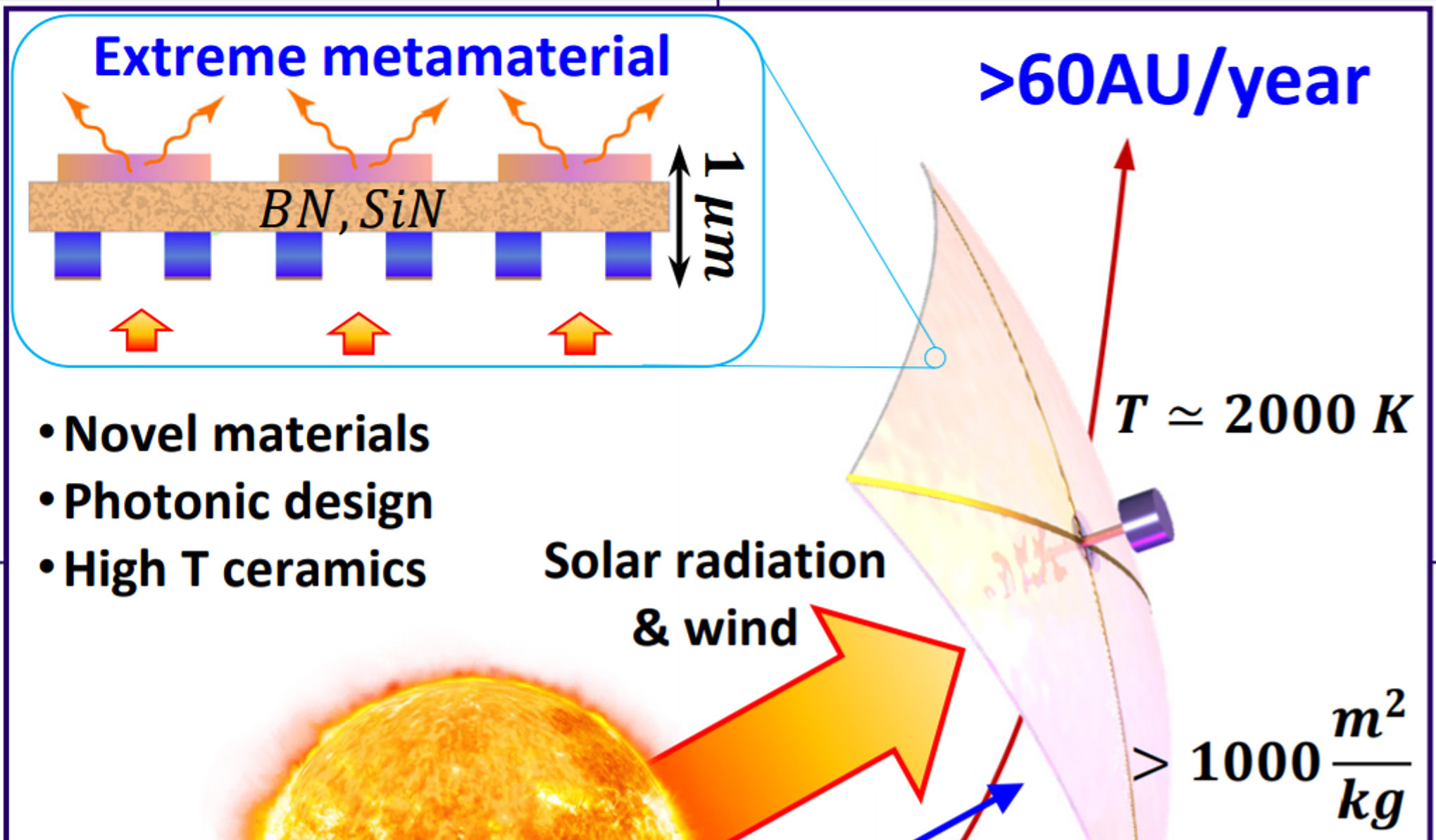Understanding the beginnings of the Universe and life itself is NASA’s long term vision and one of humanities’ grand challenges. Missions to the edge of our solar system and to space between stars in our galaxy – the interstellar medium – are of a great promise to shed light on these questions. However, today’s deep space exploration is hindered by fundamental limitations of current propulsion technology, resulting in missions that take decades of development, years of flight and cost billions.
Above – Image depicting the Extreme Metamaterial Solar Sails for Breakthrough Space Exploration concept. Credits: Artur Davoyan
Extreme metamaterial solar sails as proposed here have the potential to shift the paradigm of space exploration enabling numerous low cost and high-speed missions to be launched anytime and anywhere. Such sails could gain accelerations over 60AU/yr (about 0.1% of light speed) when coupled to low mass spacecraft and dive to extreme proximity to the sun (just 2-5 solar radii). This velocity is 20 times more than Voyager 1.
This NIAC challenges the limits of materials, paving the way for the development of high endurance ultrathin film architectures that can handle extreme environments manifested by solar radiation and plasma in addition to providing spacecraft control.
The technology will enable reaching Jupiter in 5 months, Neptune in 10, surpassing Voyager 1 in 2.5 years and getting to the solar gravity lens location in just 8.5 years.
Davoyan’s vision is to use nanotechnology to build spaceprobes that can reach Mars in a matter of days and reach distant interstellar places no one has gone before. It took Voyager nearly 40 years to reach the boundaries of our solar system, and it will take it another 50,000 years to arrive to the nearest star. Davoyan hopes to build a spacecraft that can travel at thousands of kilometers per second.
His team is using principles of nanophotonic design to develop new ultralightweight systems for space solar power harvesting and efficient regulation of spacecraft temperature via thermal radiation emission.
SOURCES- NASA NIAC, UCLA
Written By Brian Wang, Nextbigfuture.com

Brian Wang is a Futurist Thought Leader and a popular Science blogger with 1 million readers per month. His blog Nextbigfuture.com is ranked #1 Science News Blog. It covers many disruptive technology and trends including Space, Robotics, Artificial Intelligence, Medicine, Anti-aging Biotechnology, and Nanotechnology.
Known for identifying cutting edge technologies, he is currently a Co-Founder of a startup and fundraiser for high potential early-stage companies. He is the Head of Research for Allocations for deep technology investments and an Angel Investor at Space Angels.
A frequent speaker at corporations, he has been a TEDx speaker, a Singularity University speaker and guest at numerous interviews for radio and podcasts. He is open to public speaking and advising engagements.


Considering how lightweight these things are, aerocapture might be feasible.
Way in the future when there is some sort of infrastructure at an outer planet put there with slower spacecraft, a laser at the planet can be used to slow down the lightsail, or accelerate it toward the sun for a return trip. Until then the point you mentioned limits the usefulness of the tech.
And what’s this craft supposed to do once it gets there? Fly on by?
Expect for passing Voyager 1 (and what’s point apart from “because we could”?) we need these things to slow down and orbit when they get there. So another propulsion system for braking, then the thing is too heavy to work as a solar sail.
Kinda puts the whole thing into question when they specify a velocity and call it acceleration.